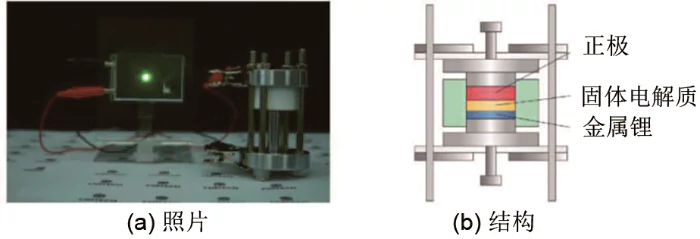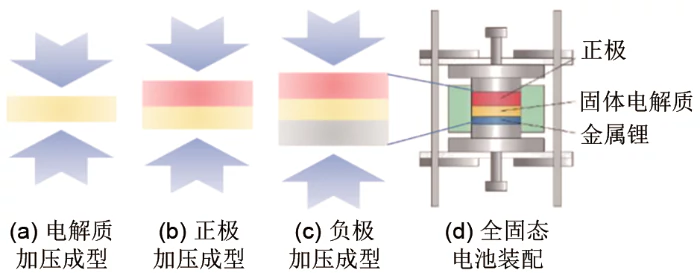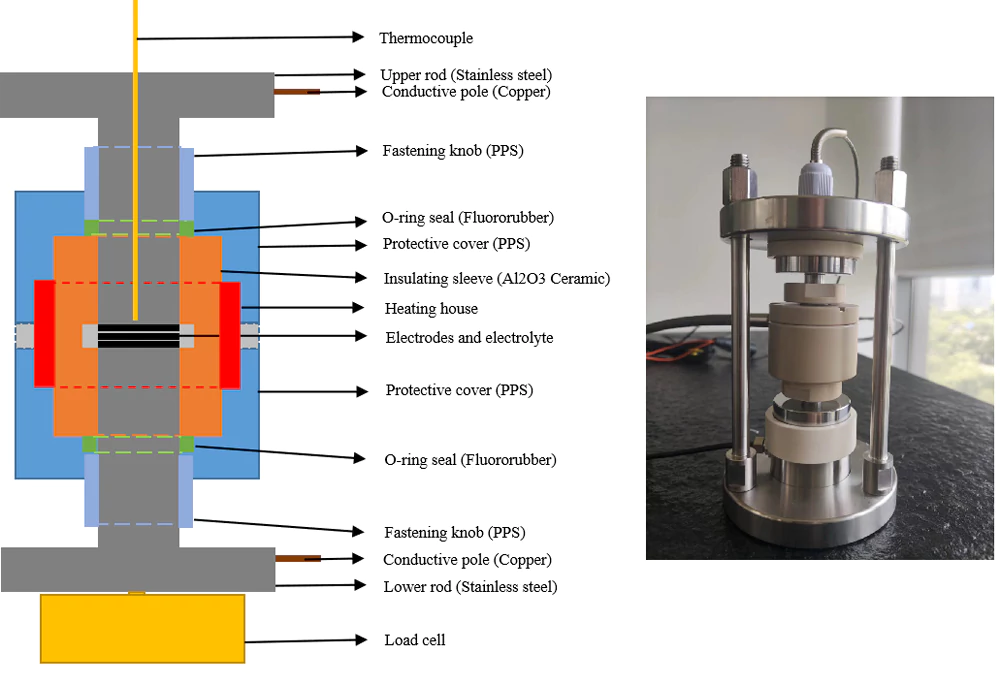In recent years, there has been rapid development of sulfide solid electrolytes including Li2S-SiS2, Li2S-B2S3, Li2S-P2S5, Li(10±1)MP2S12(M=Ge, Si, Sn, Al, P), Li6PS5X(X=Cl, Br, I). In particular, the thio-LISICON structure sulfide, represented by Li10GeP2S12 (LGPS), exhibits extremely high room temperature lithium ion conductivity of 12mS/cm exceeding that of liquid electrolytes, which has partially solved the shortcomings of insufficient intrinsic conductivity of solid electrolytes.
Figure 1(a) shows an all-solid-state lithium battery using 2.2 cm×2.2 cm Li1.5Al0.5Ge1.5(PO4)3. It is assembled from a glass-ceramic solid electrolyte sheet, LiFePO4 positive electrode material, PEO-based polymer modification layer and metallic lithium negative electrode. It can discharge normally at room temperature and light up LED lights. The schematic structural diagram of its core components is shown in Figure 1(b). It can be seen from it that the positive electrode layer, inorganic solid electrolyte layer, negative electrode interface modification layer, and lithium foil are closely connected, and their materials and composition have a decisive impact on battery performance. The preparation of each component is described in detail below.

Fig. 1 All-solid-state lithium battery basedon oxide solid electrolyte
The Young's modulus of sulfide electrolyte powder is about 20 GPa, it has high adhesion and compressibility, is prone to plastic deformation, and has low grain boundary resistance after cold pressing. Therefore, during the preparation of the positive electrode layer, it is suitable to be directly dry-mixed with the positive electrode powder [Figure 2(a)]. During dry mixing, the conductive agent, sulfide electrolyte, and cathode material are added to the mortar at the same time, and then grinded manually or mechanically mixed in a mixer. It should be noted that the matching of different cathode materials and electrolytes, the applicable occasions of different conductive agents, and different cathode coating layers need to be considered under actual conditions. For example, Tan et al. [30] investigated the different effects of VGCF and carbon black generated in the gas phase on the decomposition of LPSC. It was found that Li-In/LPSC/LPSC-carbon batteries using 30% mass fraction of carbon black and vapor deposition grown carbon fibers were charged. Batteries using carbon black show higher decomposition capabilities and faster decomposition kinetics compared to carbon fibers with smaller specific surface areas. At the same time, it compared the charge and discharge curves of Li-In/LPSC/NCM811 half cells with two conductive additives. The results show that batteries showing reduced electrolyte decomposition when using vapor deposition grown carbon fibers as additives. Compared with carbon black additives, the coulombic efficiency of the first cycle is higher and the battery polarization is lower.

Fig. 2 Preparation of the cathode for all-solid-state lithium battery cathode based on sulfide solid electrolyte
When preparing sulfide batteries in high-volume roll-to-roll production, the wet coating process [Figure 2(b)] may be more suitable for scale-up. This is due to the need to use polymer binders and solvents to make thin film electrolyte layers and electrode layers in order to provide the mechanical properties required for high-throughput roll-to-roll processes. Furthermore, the presence of flexible polymers in the electrolyte/electrode can effectively buffer the stress and strain generated by repeated charge-discharge cycles and mitigate problems such as crack formation and particle shedding. However, the following issues need to be noted during the preparation process. ① The polymer adhesive should be dissolved in a non-polar or less polar solvent (such as xylene) with negligible reactivity with sulfides. ②Polymer adhesives with strong adhesion ability should be used, otherwise excess polymer will adversely affect the conductivity and thermal stability of the electrolyte/electrode. ③Polymer adhesives need to be highly flexible. Although polymers such as polystyrene (PS) and polymethylmethacrylate (PMMA) can be dissolved in xylene, they are extremely hard after the solvent dries. It will cause the electrolyte/electrode to be crushed, so nitrile rubber (NBR) and styrene-butadiene rubber are chosen for most work. The problem with rubber, however, is that it cannot generate ionic conductivity internally, which significantly degrades the electrochemical performance of the battery even when using only small amounts of nitrile rubber. For this reason, the use of polymers with high ionic conductivity, high thermal stability, soluble in non-polar or less polar solvents, and insoluble polysulfides is the future development direction of sulfide electrolyte wet coating. Oh et al. [31] prepared a 70 μm thick flexible sulfide electrolyte membrane and positive electrode by mixing and coating triethylene glycol dimethyl ether, lithium bistrifluoromethanesulfonimide (LiTFSI), LPSC, and NBR. After matching metallic lithium, the LiNi0.6Co0.2Mn0.2O2//Li battery has a specific capacity of 174 mA·h/g, and the loading capacity of the cathode material can reach 45 mg/cm2.
However, wet pulping in the above process will use a large amount of solvent, which will inevitably lead to some small molecules of the solvent remaining in the mixture [32], and then side reactions will occur, resulting in a decrease in electrolyte conductivity and serious attenuation of battery life. The extent of the polymer binder in the solution wrapping the active material is difficult to control, which can easily lead to load transfer failure. The volatilization of the solvent results in a lower density of the electrode sheet, which is not conducive to the kinetic process of the battery. In addition, the emission and recycling of the solvent after scale-up are also unavoidable issues. Therefore, dry coating technology using PTFE [Figure 2(c)] has become another option. It mainly includes three steps: ① dry-mix the electrolyte, electrode, and PTFE ball mill; ② roll the powder into a film; ③ roll the film and current collector into shape. Because the intermolecular force between the fluorine-carbon chains in PTFE is extremely low, the molecular chain has good flexibility. Large molecular weight PTFE fine powder particles will produce fibrillation under the action of directional force, that is, the particles within the particles are regularly arranged in a certain direction under the action of shear force to form fibrous and network structures [33]. Therefore, a large number of active materials, electrolytes, and conductive carbon can be connected tightly but not completely covered. Hippauf et al. [34] found that a 93 μm thick self-supporting cathode membrane can be prepared by dry coating technology using NCM cathode, sulfide electrolyte, and VGCF using only 0.3% mass fraction of PTFE. At the same time, it shows a high surface capacity of 6.5 mA·h/cm2. Duong et al. [35] used various anode materials (such as silicon-based materials and lithium titanate) and cathode materials (such as NMC, NCA, LFP, sulfur) to prepare roll-to-roll dry electrodes and successfully commercialized them. Lee et al. [36] also used dry coating technology to prepare a high-capacity sulfide battery cathode that can be stably cycled for 1000 times in the laboratory. The above work fully proves the stability and universality of the dry coating electrode process in sulfide all-solid-state lithium batteries.
2. Preparation method of anode
The Thio-LISICON structure ternary sulfide electrolyte has high conductivity. However, according to experimental and computational work reports [37], metallic lithium reacts spontaneously and gradually with extended interfaces with LGPS, Li10Sn2PS12, etc. Some interface phases with low ion conductivity such as Li2S, Li3P, etc. and high electronic conductivity such as Li15Ge4 will be produced. This leads to an increase in the interface impedance of Li/LGPS and a short circuit in the all-solid-state lithium battery, which seriously restricts the development of its high-energy-density all-solid-state lithium battery. In order to improve the chemical/electrochemical stability of sulfide electrolytes, especially ternary sulfides containing germanium, tin, zinc, etc., to metallic lithium, there are currently three main solutions.
(1) The surface of metallic lithium is treated to generate a surface ion conductivity modification layer in situ to protect the sulfide electrolyte. As shown in Figure 3(a), Zhang et al. [25] controlled the LiH2PO4 protective layer formed by the reaction of Li and pure H3PO4 to increase the contact area between the modified layer and metallic lithium and avoid direct contact between metallic lithium and LGPS. It prevents the mixed ion electronic conductivity intermediate phase from penetrating into the interior of LGPS and improves the problem of sluggish interface lithium ion dynamics. The results show that through the modification of LiH2PO4, the lithium stability of LGPS is significantly improved, and the LCO/LGPS/LiH2PO4-Li all-solid-state lithium battery can provide ultra-long cycle life and high capacity. That is, at 25°C and 0.1 C rate, the reversible discharge capacity of the 500th cycle remains at 113.7 mA·h/g, with a retention rate of 86.7%. Li/Li symmetrical batteries can cycle stably for more than 950 hours at a current density of 0.1 mA/cm2.

Fig. 3 Modification of the anode for all-solid-state lithium battery based on sulfide solid electrolyte
(2) Use a layer of transition layer sulfide electrolyte that is stable to metallic lithium to protect the other layer. As shown in Figure 3(b), Yao et al. [38] proposed a LGPS/LPOS double-layer electrolyte structure to improve the ion conduction and stability of the LGPS/Li interface. And achieved good results in various battery systems [39], but the thicker double-layer electrolyte may reduce the overall mass energy density of the battery. The assembly method is to first cold-press a layer of electrolyte, then cold-press a layer of electrolyte on its surface, and then stack the positive and negative electrodes and apply pressure together.
(3) Generate a modification layer in situ on the electrolyte surface (electrolyte/electrode interface). As shown in Figure 3(c). Gao et al. [40] used 1 mol/L LiTFSI DOL-DME electrolyte dropwise to the LGPS/Li interface to generate organic-inorganic mixed lithium salts such as LiO-(CH2O)n-Li, LiF, -NSO2-Li, and Li2O. The Li/LGPS/Li symmetric battery was stably cycled at 0.1 mA/cm2 for 3000 h. Chien et al. [41] used solid-state nuclear magnetic imaging to study and found that the interface Li was significantly lost after cycling of Li/LGPS/Li symmetrical batteries, and the lack of interface Li and its uneven deposition could be improved by coating PEO-LiTFSI. Wang et al. [42] modified the polymer Alucone on the surface of Li10SnP2S12 through molecular layer deposition. The results showed that the reduction of Sn4+ was significantly inhibited. The above method improves the compatibility between the sulfide electrolyte and the lithium metal anode to a certain extent, but there may also be problems such as the principle of dripping electrolyte has not been clarified, and the addition of polymers leads to a reduction in the thermal stability of the electrolyte.
3. Assembly method of sulfide solid electrolyte-based all-solid-state lithium battery
The assembly of sulfide solid electrolyte-based all-solid-state lithium battery is mainly divided into the following steps, as shown in Figure 4. ① Electrolyte is pressurized and molded. The general pressing pressure is 120~150 MPa. ② The positive electrode is press-formed and a steel sheet is attached as a current collector. The general pressure is 120 to 150 MPa. ③The negative electrode is press-formed. For lithium metal, the general pressure is 120-150 MPa, and for graphite, the general pressure is 250-350 MPa, and a steel sheet is attached as a current collector. ④Tighten the battery bolts. It should be noted that the indication on the hydraulic press meter should be converted according to the actual battery mold shape, and at the same time, the battery should be prevented from short circuiting during assembly.

Fig. 4 Assembly method of all-solid-state lithium battery based on sulfide solid electrolyte.


CUI Yanming. Prototype all-solid-state battery electrodes preparation and assembly technology[J]. Energy Storage Science and Technology, 2021, 10(3): 836-847